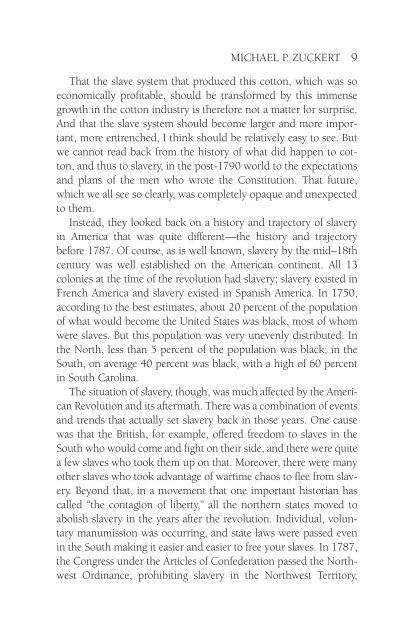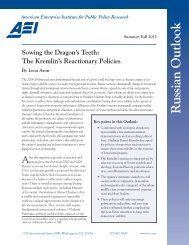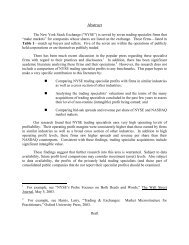Download the PDF - American Enterprise Institute
Download the PDF - American Enterprise Institute
Download the PDF - American Enterprise Institute
Create successful ePaper yourself
Turn your PDF publications into a flip-book with our unique Google optimized e-Paper software.
MICHAEL P. ZUCKERT 9<br />
That <strong>the</strong> slave system that produced this cotton, which was so<br />
economically profitable, should be transformed by this immense<br />
growth in <strong>the</strong> cotton industry is <strong>the</strong>refore not a matter for surprise.<br />
And that <strong>the</strong> slave system should become larger and more important,<br />
more entrenched, I think should be relatively easy to see. But<br />
we cannot read back from <strong>the</strong> history of what did happen to cotton,<br />
and thus to slavery, in <strong>the</strong> post-1790 world to <strong>the</strong> expectations<br />
and plans of <strong>the</strong> men who wrote <strong>the</strong> Constitution. That future,<br />
which we all see so clearly, was completely opaque and unexpected<br />
to <strong>the</strong>m.<br />
Instead, <strong>the</strong>y looked back on a history and trajectory of slavery<br />
in America that was quite different—<strong>the</strong> history and trajectory<br />
before 1787. Of course, as is well known, slavery by <strong>the</strong> mid–18th<br />
century was well established on <strong>the</strong> <strong>American</strong> continent. All 13<br />
colonies at <strong>the</strong> time of <strong>the</strong> revolution had slavery; slavery existed in<br />
French America and slavery existed in Spanish America. In 1750,<br />
according to <strong>the</strong> best estimates, about 20 percent of <strong>the</strong> population<br />
of what would become <strong>the</strong> United States was black, most of whom<br />
were slaves. But this population was very unevenly distributed. In<br />
<strong>the</strong> North, less than 5 percent of <strong>the</strong> population was black; in <strong>the</strong><br />
South, on average 40 percent was black, with a high of 60 percent<br />
in South Carolina.<br />
The situation of slavery, though, was much affected by <strong>the</strong> <strong>American</strong><br />
Revolution and its aftermath. There was a combination of events<br />
and trends that actually set slavery back in those years. One cause<br />
was that <strong>the</strong> British, for example, offered freedom to slaves in <strong>the</strong><br />
South who would come and fight on <strong>the</strong>ir side, and <strong>the</strong>re were quite<br />
a few slaves who took <strong>the</strong>m up on that. Moreover, <strong>the</strong>re were many<br />
o<strong>the</strong>r slaves who took advantage of wartime chaos to flee from slavery.<br />
Beyond that, in a movement that one important historian has<br />
called “<strong>the</strong> contagion of liberty,” all <strong>the</strong> nor<strong>the</strong>rn states moved to<br />
abolish slavery in <strong>the</strong> years after <strong>the</strong> revolution. Individual, voluntary<br />
manumission was occurring, and state laws were passed even<br />
in <strong>the</strong> South making it easier and easier to free your slaves. In 1787,<br />
<strong>the</strong> Congress under <strong>the</strong> Articles of Confederation passed <strong>the</strong> Northwest<br />
Ordinance, prohibiting slavery in <strong>the</strong> Northwest Territory,






